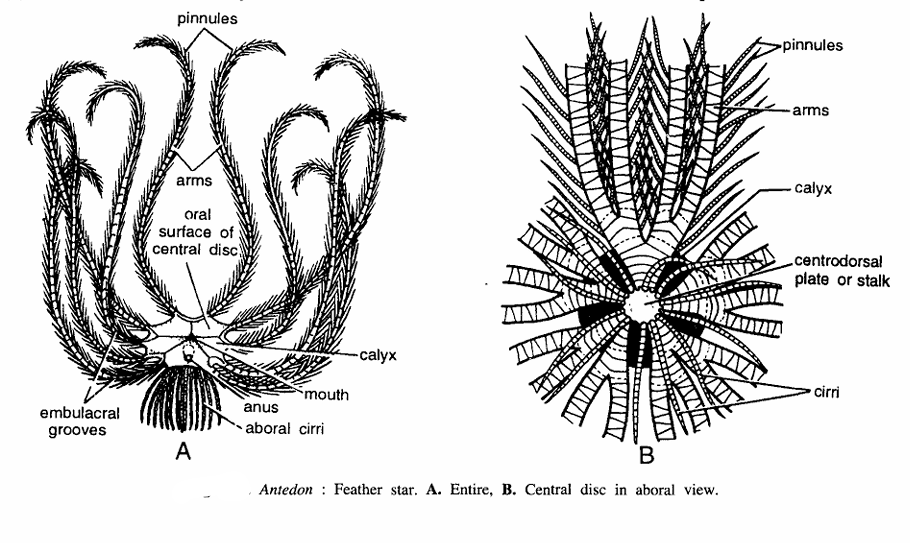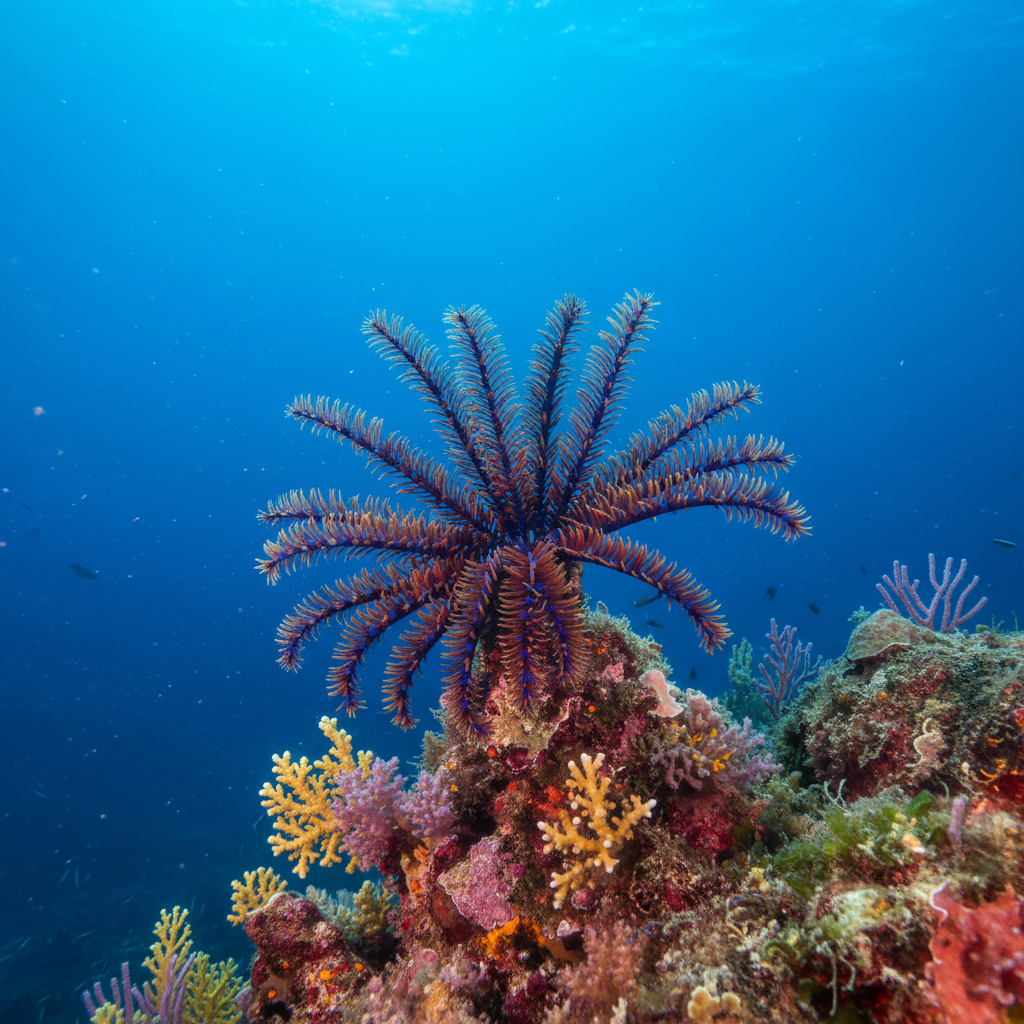Antedon: Morphology, Classification, Habitat, and Ecological Role of Feather Stars (Crinoidea)
Antedon is a genus of feather stars, which are stalkless crinoids belonging to the class Crinoidea of the phylum Echinodermata. These marine animals are known for their feathery, branched arms used both for suspension feeding and locomotion. Unlike sea lilies, which possess a stalk, Antedon species lose their stalks as adults and are free-moving. They are commonly found clinging to substrates such as rocks, seaweed, and corals in shallow tropical and temperate waters. Feather stars like Antedon play important roles in benthic ecosystems as filter feeders.
Classification of Antedon
| Taxonomic Rank | Name | Characteristics |
|---|---|---|
| Kingdom | Animalia | Multicellular eukaryotic organisms |
| Phylum | Echinodermata | Marine animals with radial symmetry and calcareous endoskeletons |
| Class | Crinoidea | Marine echinoderms with feather-like arms |
| Order | Comatulida | Stalkless, free-moving crinoids with cirri |
| Family | Antedonidae | Feather stars with claw-like cirri for attachment |
| Genus | Antedon | Stemless crinoids with five pairs of feathery arms |

Habit and Habitat
Antedon species inhabit shallow to moderately deep marine waters worldwide, often found on rocky or sandy substrates, seagrasses, algae, and coral reefs. They use their clawed cirri on the underside of the central disc to cling temporarily to surfaces. They actively feed by extending their feather-like arms into the water column to trap plankton and organic particles.
Geographical Distribution
The genus is widely distributed in tropical and temperate seas, including the Mediterranean, North Atlantic, and other coastal regions. They are notable components of benthic communities and are often particularly abundant in areas with strong currents that bring ample food.

General Characteristics
- Commonly called on sea-lily or feather-star.
- On the aboral side calyx bears a knob-like structure called as centrodorsal plate or stalk.
- The calyx is differentiated into an upper convex oral surface, having mouth and anus and the lower flat aboral surface, into which anus and cirri are inserted.
- On the aboral side calyx bears a knob-like structure, called as stung of the stalk.
- The oral surface is covered by a leathery skin in which numerous calcareous plates are embedded. It is directed upwards.
- Mouth is central and directed upwards which leads into 5 food open grooves or ambulacral grooves, which divide into 10 as they reach near the edge and lead into the anus.
- The mouth is surrounded by sensory tube feet or podia which are without suckers.
- The ambulacral grooves give branches into each pinnule and throughout their course contain finger-like, non-prehensile tube feet or podia.
- Water vascular system is well developed.
- There is no madreporite.
- There are 10 arms having extensions of viscera and each bears numerous pinnules containing gonads. The cirri are emerging from aboral surface and are composed of skeletal ossicles. Sea-lily attaches to substratum by cirri.
- Anus on aboral surface.
- It is one of the living representatives of the class Crinoidea. Sexes are separate. Development includes cystidian and pentacrinoid larva.
- Body Structure: Central concave disc (calyx) with five pairs of flexible, feathery arms.
- Cirri: Numerous clawed appendages on the dorsal ossicle, used for attachment.
- Feeding: Suspension feeders using tube feet on arms to capture food particles.
- Coloration: Variable; species can be white, yellow, orange, red, brown, or purple.
- Mobility: Capable of crawling, clinging, and swimming by rhythmically moving arms.
Special Features
- Regeneration: Can autotomize (detach) arms to escape predation and regenerate them.
- Reproduction: Separate sexes without sexual dimorphism; external fertilization.
- Larvae: Produce free-swimming, barrel-shaped larvae called doliolaria that settle and develop stalks before becoming free-moving adults.
- Cirri and Locomotion: Cirri provide strong attachment in high-current areas; locomotion aids in feeding and predator avoidance.

Identification
Identification of species relies on:
- Number and shape of cirri.
- Feathering and segmentation of arms and pinnules.
- Size and coloration patterns.
- Geographic locality and ecological habitat.
Life Cycle and Reproduction
Antedon exhibits separate sexes with external fertilization. Females carry eggs attached to pinnules of their arms until free-swimming larvae hatch. Larvae settle initially with stalks and later detach to advance to adult forms. Reproductive activity may vary seasonally, with some species reproducing year-round.
Ecological Role and Importance
- Benthic Filter Feeders: Play vital roles in nutrient cycling and water filtration.
- Habitat Structure: Provide habitat complexity for smaller marine organisms.
- Biodiversity Indicators: Reflect health and biodiversity of marine benthic ecosystems.
- Prey for Predators: Feed by capturing plankton but also serve as food for fishes and invertebrates.
- Regeneration Model: Studies on their regeneration contribute to biological research.
References
- https://en.wikipedia.org/wiki/Antedon
- https://www.biologydiscussion.com/invertebrate-zoology/phylum-echinodermata/antedon-an-example-of-phylum-echinodermata/33744
- https://www.vedantu.com/question-answer/antedon-is-a-member-of-the-class-a-echinoidea-b-class-11-biology-cbse-5f5f5c018f2fe24918f4bbc9
- https://www.marlin.ac.uk/species/detail/1521
- https://en.wikipedia.org/wiki/Antedon_mediterranea
- https://www.habitas.org.uk/marinelife/species.asp?item=ZB120
- https://byjus.com/biology/echinodermata/
- https://www.marlin.ac.uk/habitats/detail/313/antedon_spp_solitary_ascidians_and_fine_hydroids_on_sheltered_circalittoral_rock
- https://www.tandfonline.com/doi/full/10.1080/11250000802086011
- https://patnawomenscollege.in/upload/e-content/General-Characteristics-and-Classification-of-Echinodermata.pdf

